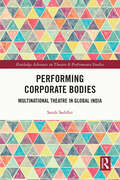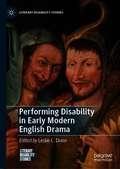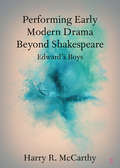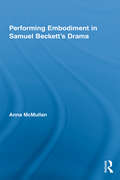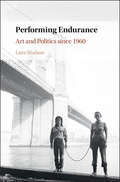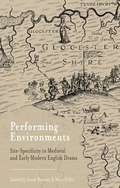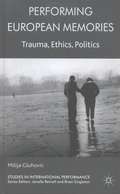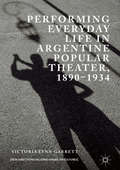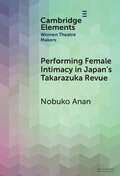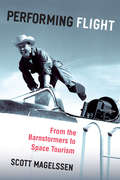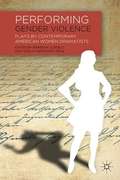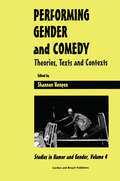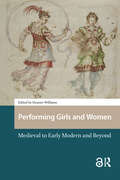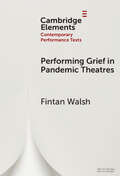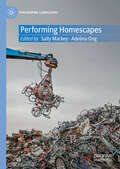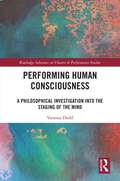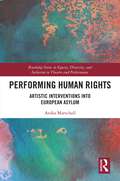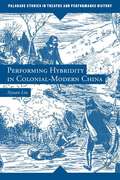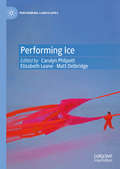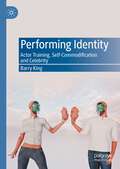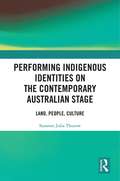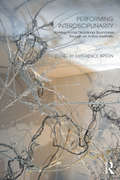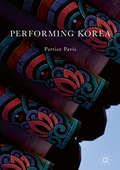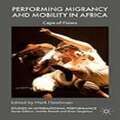- Table View
- List View
Performing Corporate Bodies: Multinational Theatre in Global India (Routledge Advances in Theatre & Performance Studies)
by Sarah SaddlerThis book offers the first look at corporate theatre, a global management trend that uses dramatic techniques in workplace learning.Drawing on a decade of research with artists, consultancies, drama schools, and multinational firms in India and across the Global South, Sarah Saddler provides a fascinating perspective on why theatre and performance are finding new legitimacy in corporate economies under late capitalism. Chapters spotlight how theatre is wielded by management to advance urgent corporate agendas, while examining corporate theatre’s impact on broader social transformations, such as the theatrical dimensions of management and shifting creative horizons for performance practitioners. Through vivid vignettes, Sarah Saddler argues that corporate theatre has become a mode of physical and psychological conditioning used to encode the cultural dimensions of global capitalism. Simultaneously, she uncovers how corporate theatre employs humor tactics that enable individuals to navigate systems of power, becomes a remedy for corporations grappling with the crushing competition of capitalism, and offers a critical perspective on artistic agency within the creative economy.This book will be of interest to readers across the interdisciplinary humanities including theatre and performance studies, anthropology, sociology, and South Asian studies.
Performing Disability in Early Modern English Drama (Literary Disability Studies)
by Leslie C. DunnPerforming Disability in Early Modern English Drama investigates the cultural work done by early modern theatrical performances of disability. Proffering an expansive view of early modern disability in performance, the contributors suggest methodologies for finding and interpreting it in unexpected contexts. The volume also includes essays on disabled actors whose performances are changing the meanings of disability in Shakespeare for present-day audiences. By combining these two areas of scholarship, this text makes a unique intervention in early modern studies and disability studies alike. Ultimately, the volume generates a conversation that locates and theorizes the staging of particular disabilities within their historical and literary contexts while considering continuity and change in the performance of disability between the early modern period and our own.
Performing Early Modern Drama Beyond Shakespeare: Edward's Boys (Elements in Shakespeare Performance)
by Harry McCarthyThis Element provides the first in-depth study of the present-day all-boy company, Edward's Boys, who are based at King Edward VI School ('Shakespeare's School') in Stratford-upon-Avon. Since 2005, the company has produced a wide array of early modern plays, providing the most substantial repertory of early modern drama available for examination by scholars. The Element provides a comprehensive account of the company's practices, drawing on extensive rehearsal and performance observation, evidence from the company's archive, and interviews with actors and key company personnel. The Element takes account of the company's particular educational and strongly interpersonal environment, suggesting that these factors have a distinctive shaping force on their performance practice. In the hands of Edward's Boys, the Element argues, early modern drama becomes the source of company creation, ensemble practice, and virtuosic physical play, inviting us to reimagine what it means – and takes – to perform these plays today.
Performing Embodiment in Samuel Beckett's Drama (Routledge Advances In Theatre And Performance Studies #12)
by Anna McMullanThe representation and experience of embodiment is a central preoccupation of Samuel Beckett’s drama, one that he explored through diverse media. McMullan investigates the full range of Beckett’s dramatic canon for stage, radio, television and film, including early drama, mimes and unpublished fragments. She examines how Beckett’s drama composes and recomposes the body in each medium, and provokes ways of perceiving, conceiving and experiencing embodiment that address wider preoccupations with corporeality, technology and systems of power. McMullan argues that the body in Beckett’s drama reveals a radical vulnerability of the flesh, questioning corporeal norms based on perfectible, autonomous or invulnerable bodies, but is also the site of a continual reworking of the self, and of the boundaries between self and other. Beckett’s re-imagining of the body presents embodiment as a collaborative performance between past and present, flesh and imagination, self and other, including the spectator / listener.
Performing Endurance: Art and Politics since 1960
by Lara ShalsonIn Performing Endurance, Lara Shalson offers a new way of understanding acts of endurance in art and political contexts. Examining a range of performances from the 1960s to the present, including influential performance art works by Marina Abramović, Chris Burden, Tehching Hsieh, Linda Montano, Yoko Ono, and others, as well as protest actions from the lunch counter sit-ins of the US civil rights movement to protest camps in the twenty-first century, this book provides a formal account of endurance and illuminates its ethical and political significance. Endurance, Shalson argues, raises vital questions about what it means to exist as a body that both acts and is acted upon, from ethical questions about how we respond to the bodies of others to political questions about how we live in relation to institutions that shape life in fundamental ways. In addition, Performing Endurance rethinks how performance itself endures over time.
Performing Environments
by Susan Bennett Mary PolitoThis ground-breaking collection explores the assumptions behind and practices for performance implicit in the manuscripts and playtexts of the medieval and early modern eras, focusing on work which engages with performance-oriented research.
Performing European Memories
by Milija GluhovicAsking whether a genuinely shared European memory is possible while addressing the dangers of a single, homogenized European memory, Gluhovic examines the contradictions, specificities, continuities and discontinuities in the European shared and unshared pasts as represented in the works of Pinter, Tadeusz Kantor, Heiner Muller and Artur Zmijewski.
Performing Everyday Life in Argentine Popular Theater, 1890–1934 (New Directions In Latino American Cultures Ser.)
by Victoria Lynn GarrettThis book examines the prolific and widely-attended popular theater boom of the género chico criollo in the context of Argentina’s modernization. Victoria Lynn Garrett examines how selected plays mediated the impact of economic liberalism, technological changes, new competing and contradictory gender roles, intense labor union activity, and the foreign/nativist dichotomy. Popular theaters served as spaces for cultural agency by portraying conventional and innovative performances of daily life. This dramatic corpus was a critical mass cultural medium that allowed audiences to evaluate the dominant fictions of liberal modernity, to critique Argentina’s purportedly democratic culture, and to imagine alternative performances of everyday life in accordance with their realities. Through a fresh look at the relationship among politics, economics, popular culture, and performance in Argentina’s modernization period, the book uncovers largely overlooked articulations of popular-class identities and desires for greater inclusion that would drive social and political struggles to this day.
Performing Female Intimacy in Japan's Takarazuka Revue (Elements in Women Theatre Makers)
by Nobuko AnanJapan's Takarazuka Revue is arguably the most commercially successful all-female theatre company in the world. Renowned for its glamour-laden staging of musicals and revues, the company's signature shows are heterosexual Western romances where women play both male and female roles. Since its audience consists almost entirely of women, Takarazuka creates a space for queer intimacy between performers and ardent female fans. This Element analyses the recent experimental show, The Poe Clan, directed by Koike Shūichirō, which portrays a male homoerotic relationship, argued as a façade for a queer, kin-like relationship between women. It also explores works by the female director Ueda Kumiko, which depict an anti-capitalist shared commons for female intimacy. These shows exhibit resistant girls' aesthetics, expressed in the company's two-dimensional performance style.
Performing Flight: From the Barnstormers to Space Tourism
by Scott MagelssenPerforming Flight sheds new light on moments in the history of US aviation and spaceflight through the lens of performance studies. From pioneering aviator Bessie Coleman to the emerging industry of space tourism, performance has consistently shaped public perception of the enterprise of flight and has guaranteed its success as a mode of entertainment, travel, research, and warfare. The book reveals fundamental connections between performance and human aviation and space travel over the past 100 years, beginning with the early aerial entertainers known as barnstormers (named after itinerant 19th century theater troupes) to the performative history of the Enola Gay and its pilot Paul Tibbets, who dropped the bomb on Hiroshima, thus ushering in the atomic age. The book also explores the phenomenon of “the pilot voice”; the creation of the American Astronaut, on whose performative success the Cold War, the Space Race, and funding of the US Space Program all depended; and the performative strategies employed to cement notions of space tourism as both manifest destiny and an escape route from a failed planet. A final chapter addresses the four hijacked flights of 9/11 and their representations in discourse and in memorials. Performing Flight effectively and imaginatively demonstrates the ways in which performance and flight in the United States have been inextricably linked for more than a century.
Performing Gender Violence
by Barbara Ozieblo Noelia Hernando-RealViolence against women in plays bywomen has earned little mention. This revolutionary collection fills that gap, focusing on plays by American women dramatists, written in the last thirty years, that deal with different forms of gender violence. Each author discusses specific manifestations of violence in carefully selected plays: psychological, familial, war-time, and social injustice. This book encompasses the theatrical devices used to represent violence on the stage in an age of virtual, immediate reality as much as the problematics of gender violence in modern society.
Performing Gender and Comedy: Theories, Texts and Contexts
by Hengen SFirst Published in 1998. Routledge is an imprint of Taylor & Francis, an informa company.
Performing Girls and Women: Medieval to Early Modern and Beyond (Gendering the Late Medieval and Early Modern World)
by Deanne WilliamsThis book charts the broad cultural impact of the medieval and early modern female performer: how she engages with her historical origins in classical drama, works within contemporary cultural and professional networks, and sets the terms for female performance in subsequent historical periods. Moving beyond the archival evidence that establishes that medieval and early modern women and girls performed, it explores how their performances resonated across national boundaries and historical periods, revealing wide patterns of influence and inspiration. This collection of original essays brings together well-established authorities with new and emerging scholars, offering innovative and ground-breaking discussions of medieval dramatic cultures, the Shakespearean stage, professional actresses in Spain and Italy, the performance of music and dance, artistic representations of the female performer, and twentieth- and twenty-first-century adaptations. Ranging from tenth-century Germany to twenty-first-century London, the chapters in this volume offer a new set of paradigms for understanding and interpreting women and girls on stage.
Performing Greek Comedy
by Alan HughesAlan Hughes presents a new complete account of production methods in Greek comedy. The book summarizes contemporary research and disputes, on such topics as acting techniques, theater buildings, masks and costumes, music and the chorus. Evidence is re-interpreted and traditional doctrine overthrown. Comedy is presented as the pan-Hellenic, visual art of theater, not as Athenian literature. Recent discoveries in visual evidence are used to stimulate significant historical revisions. The author has directly examined 350 vase scenes of comedy in performance and actor-figurines, in 75 collections, from Melbourne to St Petersburg. Their testimony is applied to acting techniques and costumes, and women's participation in comedy and mime. The chapters are arranged by topic, for convenient reference by scholars and students of theater history, literature, classics and drama. Overall, the book provides a fresh practical insight into this continually developing subject.
Performing Grief in Pandemic Theatres (Elements in Contemporary Performance Texts)
by Fintan WalshThis Element explores how theatre responded to the death and loss produced by the COVID-19 pandemic, by innovating forms and spaces designed to support us in grief. It considers how theatre grieved for itself, for the dead, for lost ways of living, while also imagining and enacting new modes of being together. Even as it reckoned with its own demise, theatre endeavoured to collectivise grief by performing a range of functions more commonly associated with funerary, health and social care services, which buckled under restrictions and neglect. These pandemic theatres show how grief cannot only be let mourn over individual losses in private, but how it must also seep into the public sphere to fight to save critical services, institutions, communities and art forms, including theatre itself.
Performing Homescapes (Performing Landscapes)
by Sally Mackey Adelina OngPart of the Performing Landscapes series, Performing Homescapes is an edited collection comprising a contemporary exploration of performing many iterations of landscapes of homes. Authors were invited to respond to a detailed brief with home to be deliberately reconsidered as homescape, represented by landscapes, sites and practices often outside, and occasionally including a conventional home-as-house and intimate dwelling. We wanted a diverse range of geographical sites to be represented and a global offer, encompassing a pluriverse of homescapes. Voices, practices, and epistemologies from the Global South and global majority were important to us, including Indigenous ways of knowing and practicing. This curated collection offers an expanded understanding of the performance of home/scapes as a new intervention into the fields of performance and home scholarship. Performing Homescapes moves beyond spatial meditations within rooms of a house to offer an original critical engagement with the social, political, ecological and cultural landscapes that shape and sustain affects related to the notion of home, unhomeliness and, even, solastalgia. While the impact of the social, political and cultural landscapes on relationships with - and within - the house are implied in most academic literature on forms of performing home, it is foregrounded in the chapters of this edited collection. In addition, certain chapters attend to the more-than-human, human relationships with the Earth as homescape and the co-creation of homescapes within and beyond dwellings.
Performing Human Consciousness: A Philosophical Investigation into the Staging of the Mind (ISSN)
by Vanessa DoddIs the mind like a theatrical performance? This comparison has often been used as a conceptual tool by neuroscientists, philosophers, and psychologists in trying to understand what constitutes the human mind, and in particular how the comings and goings and the character transformations on the stage and in the scripted text give us visible access to the hidden workings of the human mind.Performing Human Consciousness makes use of this metaphor to explore the variety of ways in which the private thoughts and feelings we all have bring into play many aspects of persistent philosophical questions over how the essentially private world of personal experiences can relate to and communicate with the common public world. To investigate this generalisation in more detail, the author brings into play her own conscious experiences by making use of an auto-inscribed play Being Me. Through this dramatic medium she seeks to show in detail how phenomenal consciousness is captured through the dramatic play text and thereby made known to others through performance of that text. Broadening out her argument further, the author then embarks on an enquiry into a selection of play texts from an historical variety of perspectives, from the early Greek and Mediaeval dramas, through to the Symbolist period and onwards to the present day, demonstrating the variety of ways in which they illustrate her argument. This book will be of great interest to students and scholars of theatre & performance and scriptwriting.
Performing Human Rights: Artistic Interventions into European Asylum (Routledge Series in Equity, Diversity, and Inclusion in Theatre and Performance)
by Anika MarschallThis book enhances critical perspectives on human rights through the lens of performance studies and argues that contemporary artistic interventions can contribute to our understanding of human rights as a critical and embodied doing. This study is situated in the contemporary discourse of asylum and political art practices. It argues for the need to reimagine human rights as performative and embodied forms of recognition and practical honouring of our shared vulnerability and co-dependency. It contributes to the debate of theatre and migration, by understanding that contemporary asylum issues are complex and context specific, and that they do not only pertain to the refugee, migrant, asylum seeker or stateless person but also to privileged constituencies, institutional structures, forms of organisation and assembly. The book presents a unique mixed-methods approach that focuses equally on performance analyses and on political philosophy, critical legal studies and art history – and thus speaks to a range of politically interested scholars in all four fields.
Performing Hybridity in Colonial-Modern China
by Siyuan LiuIn Shanghai in the early twentieth century, a hybrid theatrical form, wenmingxi, emerged that was based on Western spoken theatre, classical Chinese theatre, and a Japanese hybrid form known as shinpa. This book places it in the context of its hybridized literary and performance elements, giving it a definitive place in modern Chinese theatre.
Performing Ice (Performing Landscapes)
by Elizabeth Leane Matt Delbridge Carolyn PhilpottIn the Anthropocene, icy environments have taken on a new centrality and emotional valency. This book examines the diverse ways in which ice and humans have performed with and alongside each other over the last few centuries, so as to better understand our entangled futures. Icescapes – glaciers, bergs, floes, ice shelves – are places of paradox. Solid and weighty, they are nonetheless always on the move, unstable, untrustworthy, liable to collapse, overturn, or melt. Icescapes have featured – indeed, starred – in conventional theatrical performances since at least the eighteenth century. More recently, the performing arts – site-specific or otherwise – have provoked a different set of considerations of human interactions with these non-human objects, particularly as concerns over anthropogenic warming have mounted. The performances analysed in the book range from the theatrical to the everyday, from the historical to the contemporary, from low-latitude events in interior spaces to embodied encounters with the frozen environment.
Performing Identity: Actor Training, Self-Commodification and Celebrity
by Barry KingThis book examines how the persistent and deepening casualization and precarity of acting work, coupled with market pressures, has affected the ways in which actors are trained in the US and UK. It reviews the existing state of training, looking at various theories of what the actor does, debates about casting, and the impact of reality television and social media. In the increasing effort to find ways to overcome the precarious labour market for actors and other performers, the traditional emphasis on theatrical character has been replaced by the celebration of the persona – a public image of the performer as a personal brand. As a result, a physiocratic elite, that literally incorporates the collective labour of cultural workers into the star or celebrity body, has formed. This book explores how the star or celebrity’s appearance and comportment are positioned as the rule of nature, formed and abiding outside capitalism as a mode of production. This book will be of interest to those studying theatre studies and performance, contemporary stardom and celebrity and the impact of technology on the formation of identity.
Performing Indigenous Identities on the Contemporary Australian Stage: Land, People, Culture
by Susanne Julia ThurowOver the past 50 years, Indigenous Australian theatre practice has emerged as a dynamic site for the discursive reflection of culture and tradition as well as colonial legacies, leveraging the power of storytelling to create and advocate contemporary fluid conceptions of Indigeneity. Performing Indigenous Identities on the Contemporary Australian Stage offers a window into the history and diversity of this vigorous practice. It introduces the reader to cornerstones of Indigenous Australian cultural frameworks and on this backdrop discusses a wealth of plays in light of their responses to contemporary Australian identity politics. The in-depth readings of two landmark theatre productions, Scott Rankin’s Namatjira (2010) and Wesley Enoch & Anita Heiss’ I Am Eora (2012), trace the artists’ engagement with questions of community consolidation and national reconciliation, carefully considering the implications of their propositions for identity work arising from the translation of traditional ontologies into contemporary orientations. The analyses of the dramatic texts are incrementally enriched by a dense reflection of the production and reception contexts of the plays, providing an expanded framework for the critical consideration of contemporary postcolonial theatre practice that allows for a well-founded appreciation of the strengths yet also pointing to the limitations of current representative approaches on the Australian mainstage. This study will be of great interest to students and scholars of Postcolonial, Literary, Performance and Theatre Studies.
Performing Interdisciplinarity: Working Across Disciplinary Boundaries Through an Active Aesthetic
by Experience BryonPerforming Interdisciplinarity proposes new ways of engaging with performance as it crosses, collides with, integrates and/or disturbs other disciplinary concerns. From Activism and Political Philosophy to Cognitive Science and Forensics, each chapter explores the relationships between performance and another discipline. Including cross-chapter discussions which address the intersections between fields, Performing Interdisciplinarity truly examines the making of meaning across disciplinary conventions. This is a volume for performance practitioners and scholars who are living, learning, writing, teaching, making and thinking at the edges of their specialisms.
Performing Korea
by Patrice PavisThis book offers an exploration of the intersection of Korean theatre practice with Western literary theatre. Gangnam Style, K-Pop, the Korean Wave : who hasn't heard of these recent Korean phenomena? Having spent two years in Korea as a theatrical and cultural 'tourist', Patrice Pavis was granted an unparalleled look at contemporary Korean culture. As well as analyzing these pop culture mainstays, however, he also discovered many uniquely Korean jewels of contemporary art and performance. Examining topics including contemporary dance, puppets, installations, modernized pansori, 'Koreanized' productions of European Classics and K-pop and its parody, this book provides a framework for an intercultural and globalized approach to Korean theatre. With the first three chapters of the book outlining methodology, the remaining chapters test - often deconstructing and transforming in the process - this framework, using focused case studies to introduce the reader to the cultural and artistic world of a nation with an increasing international presence in theatre and the arts alike.
Performing Migrancy and Mobility in Africa
by Mark FleishmanPerforming Migrancy and Mobility in Africa focuses on a body of performance work, the work of Magnet Theatre in particular but also work by other artists in Cape Town and other parts of the continent or the world, that engages with the Cape as a real or imagined node in a complex system of migration and mobility. Located at the foot of the African continent, lodged between two oceans at the intersection of many of the earth's major shipping lanes, Cape Town is a stage for a powerful mixing of cultures and peoples and has been an important node in a network of flows, circuits of movement and exchange. The performance works studied here attempt to get to grips with what it feels like to be on the move and in the spaces in-between that characterises the lives, now and for centuries before, of multiple peoples who move around and pass through places like the Cape. The contributors are a broad range of mostly African authors from various parts of the continent and as such the book offers an insight into new thinking and new approaches from an emerging and important location.
